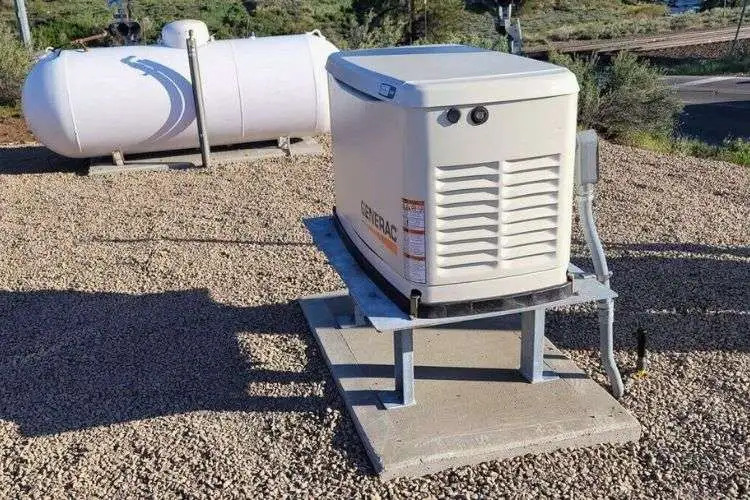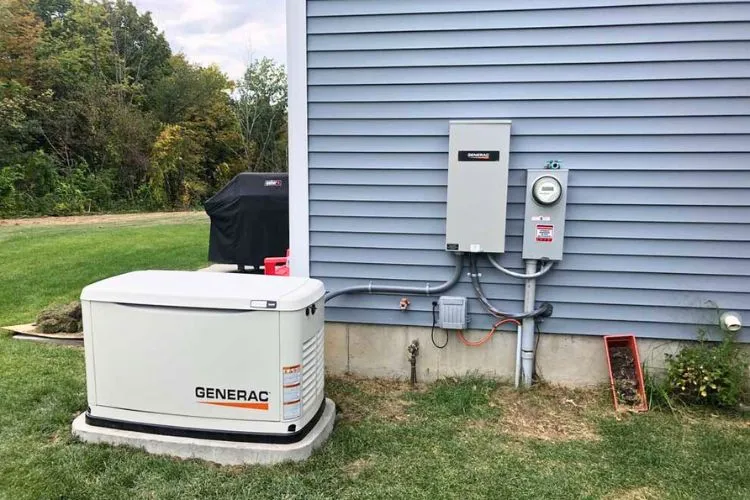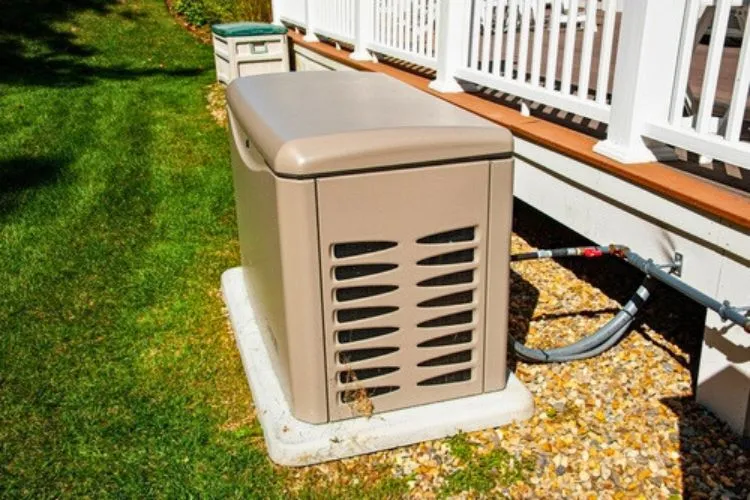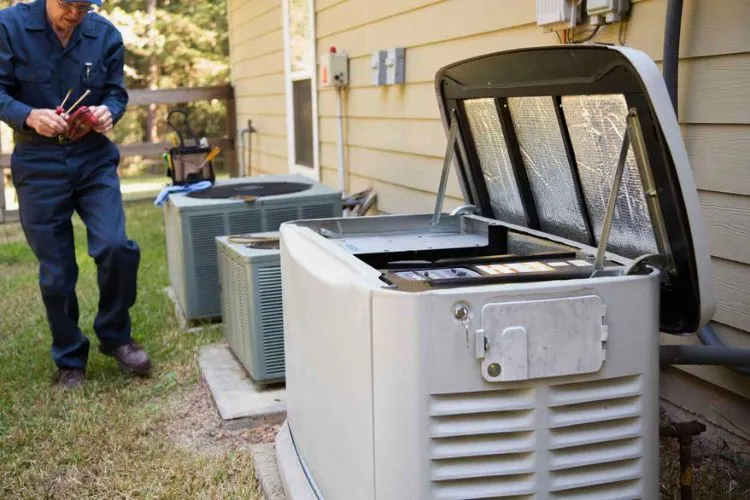Generators are essential machines that offer backup power during electricity blackouts. They come in handy to power appliances and ensure that essential activities such as cooking and lighting continue as usual.
Therefore, when setting up a generator, the distance from the house is critical to ensure safety. But, exactly how far should a generator be from the house?
However, it’s essential to understand that generators emit harmful gasses that can be dangerous when inhaled. These gasses can lead to carbon monoxide poisoning, which can be deadly.

In this article, we will discuss and provide guidelines on how far the generator should be from the house to prevent harm and ensure the safe operation of the generator.
How far should a generator be from the house?
A generator should be placed at least 15 to 20 feet away from the house. This distance is crucial to ensure the safety of occupants and prevent the risk of carbon monoxide poisoning.
When a generator is operated too close to a building, the fumes it produces can seep inside through windows, doors, and ventilation systems, putting everyone in the house at risk.
Additionally, it is important to consider the positioning of the generator in relation to windows and air intakes.
Placing the generator downwind from these openings is crucial to prevent fumes from entering the house.
The prevailing wind direction should be taken into account to determine the optimal placement of the generator.
Proper ventilation is also key to ensuring safety. Generators should never be operated indoors or in enclosed spaces such as garages or basements. Adequate airflow around the generator is necessary to dissipate the harmful gases it emits.
Furthermore, it is essential to adhere to manufacturer’s recommendations and guidelines regarding generator placement. Different types and models of generators may have specific requirements that need to be followed to ensure safe operation.
In summary, the ideal distance between a generator and a house should be at least 15 to 20 feet.
Adhering to this guideline, considering wind direction, ensuring proper ventilation, and following manufacturer’s recommendations will minimize the risk of carbon monoxide poisoning and ensure the safety of everyone in the house.
How far does a Generac generator need to be from the house?
According to Generac’s official guidelines, for a home standby generator, there should be at least 18 inches (around 1.5 feet) of clearance from the back of the generator to a stationary wall or a building.
This distance ensures that the generator does not overheat, and there is enough room for servicing.
The generator should also have a minimum of 5 feet clearance from any house openings such as windows or doors. This clearance measure is crucial for preventing exhaust gases, including carbon monoxide, from entering the house.

You should install a Generac air-cooled generator with a steel or aluminum enclosure as close as 18 inches from your home considering it’s at least 5ft from door or window openings, dryer vents, furnace vents, and 3ft from the exhaust or intake end of the generator.
Always consult with local building codes or a qualified electrician before installation, as these requirements can vary from one area to another. Do NOT install home standby generators under a wooden deck or platform.
Plan the site as close as possible to a natural gas line and the electric meter to save on installation costs.
These guidelines are critical to ensure the safe operation of your Generac generator. Always refer to the manufacturer’s instructions before installation.
How far should a generator be from a window?
Sure, based on the information available, a generator should ideally be placed at least 20 feet away from a window. The exhaust fumes that generators release, including carbon monoxide, are potentially lethal.
Hence, the importance of keeping a safe distance between the generator and any openings, such as windows and doors.

Generac recommends a minimum of 5 feet clearance from the house openings, including windows. It’s important to always adhere to local codes as they may have different requirements.
Remember that it’s not just about avoiding carbon monoxide. This clearance also allows for proper air flow and cooling for the generator.
It’s important to place the generator safely and follow the recommended guidelines and local codes. When in doubt, always consult with an expert.
Where is the safest place to put a generator?
Generators can be a lifesaver during power outages, but they can also be lethal if not properly placed.

It’s crucial to select a suitable location for your generator that ensures their safe and efficient operation. Let’s look at several key aspects of generator placement.
- Outdoor Area: You should always place your generator outdoors, away from your home. It’s essential never to run a generator indoors, in a garage, or any other enclosed space due to the risk of carbon monoxide poisoning.
- From the House: As mentioned earlier, the generator should be situated at least 15 to 20 feet away from your house. Ensure that it’s far enough to prevent hazardous exhaust gases from seeping into your house through windows, doors, or air vents.
- Away from Flammable Substances: Generators tend to get hot when in operation. Position your generator away from flammables like gas tanks, brushes, or any combustible materials to minimize the risk of accidental fire.
- Sheltered and Secure: Protect your generator from the elements by placing it under a canopy or other types of cover. Ensure it’s secure from tampering or theft by locking it in a safety cage or chaining it to an immovable object.
- Ventilation: Provide sufficient ventilation around the generator. Even though it’s placed outdoors, there should be ample free space around it for adequate airflow.
- Topography: Place your generator on a flat, firm surface to avoid tipping over. The site should also be safe from flooding or water pooling.
- Noise: Noise is another factor to consider. To avoid disturbing your neighbors or family members, place the generator in an area where the noise won’t be an issue or consider using a generator quiet box or barrier.
- Towards Prevailing Wind: Take into account the prevailing wind direction. The generator should be positioned in a way that the exhaust gasses are carried away from the home and any nearby buildings.
Adhering to the above-mentioned considerations will ensure the safe operation of your generator, safeguarding you, your family, and your property. Every generator is different, so it is key to read and follow your specific generator’s safety manual.
Generator Placement Considerations for Safety and Performance
When choosing the right spot for your generator, several factors contribute not just to safety but also to the generator’s efficiency and longevity. Proper placement can ensure that the generator operates at optimal performance while reducing risks to your health and property.
Avoiding Overheating
One important aspect of generator placement is ensuring that the generator has enough space around it to dissipate heat. Generators, particularly gasoline-powered ones, can become very hot during operation.
Placing the generator in an open area with proper clearance helps to prevent overheating, which could lead to malfunctions or even fire hazards. Ensure the exhaust is clear of any obstructions, as this can hinder airflow and potentially cause the generator to overheat.
Protection from Weather
While generators are designed for outdoor use, it is essential to place them in a location where they are somewhat protected from harsh weather conditions. Direct exposure to rain, snow, or extreme temperatures can damage the generator or cause it to malfunction.
Consider placing the generator under a weather-resistant shelter such as a canopy or a custom generator shed. However, be mindful that the shelter should not obstruct ventilation, as the generator still needs airflow to function safely.
Sound Considerations
Generators can be noisy, especially when running at full load. The noise from the exhaust system and the engine can be disruptive to your household or neighbors.
When positioning the generator, try to place it in a location that minimizes noise disturbance. If possible, install the generator away from living spaces, or consider using a soundproof enclosure to dampen the noise.
Access for Maintenance and Fueling
Another key factor in placing your generator is ease of access for regular maintenance and refueling. Ensure that the location allows you to quickly and safely add fuel, check oil levels, and inspect other vital components.
Avoid placing the generator in tight spaces that may make it difficult to perform maintenance or repairs.
By considering all these factors and following manufacturer recommendations, you can enhance the safety, performance, and longevity of your generator, ensuring that it serves you reliably when you need it most.
Conclusion:
The safe placement of a generator plays a pivotal role in preventing accidents and ensuring efficient operation during power outages.
A distance of 15-20 feet from the house is recommended, particularly away from windows and air intakes.
Additionally, variables such as prevailing wind direction, ventilation, and adherence to manufacturer’s guidelines must also be considered.
Every generator user must be aware of these safety measures to avoid problems like carbon monoxide poisoning. Always remember, safety comes first – following these guidelines ensures a safe and optimal generator usage.
